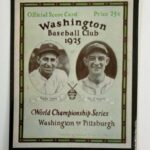Losing four consecutive World Series games to the Yankees, while distressing, hardly could qualify as an embarrassment. Others had taken the plunge against the wrecking crew from the Bronx: the Pirates, Cardinals, Cubs, Cubs again, Reds.
In fact, with their four-in-a-row dismissal of the Phillies, the Yankees had swept six World Series in 24 years (in one 13-year stretch, the Yankee broom had been wielded five times) and captured 13 World Series titles.
The truth is, the Phillies did anything but embarrass themselves in the 1950 Series.
With 20-game winner Robin Roberts having pitched three times in the last five days of the regular season in the Phils’ frantic bid to nail down the pennant, Sawyer was hard-pressed to find a starting pitcher for Game 1 of the fall classic. Compounding the problem was the late-season loss of Curt Simmons (17 victories) to the Army. Plus, rookie pitchers Bob Miller and Bubba Church had nagging injuries. Sawyer found his man, nominating a 33-year-old righthander who had not made one start in 1950. The choice: Jim Konstanty.
While Konstanty had not started, he had appeared in 74 games. The Phillies’ standout reliever was 16-7 with a 2.66 ERA. And clearly he was up to the World Series challenge. In eight innings, he allowed the Yankees only one run and four hits. Unfortunately for the Phillies, New York’s Vic Raschi spun a two-hit, 1-0 shutout.
Roberts was ready for battle in Game 2. So, too, was Yankees righthander Allie Reynolds. Battle they did, to a 1-1 standoff through nine innings. Then Joe DiMaggio cracked a leadoff homer in the 10th, and the Yanks were 2-1 winners.
Lefthander Ken Heintzelman, a 17-game winner for the Phillies in 1949 but a 3-9 pitcher for the pennant-winning team, was pressed into duty as the Game 3 starter and responded beautifully. Matched against Eddie Lopat, Heintzelman carried a 2-1 lead into the eighth but, after retiring the first two Yankees, walked three consecutive batters in the inning.
Sawyer called for Konstanty, who seemingly extricated the Phils from the mess by inducing Bobby Brown to ground to shortstop Granny Hamner. But Hamner fumbled the ball, and the tying run scored. The New Yorkers pushed over another run in the ninth — Jerry Coleman produced the game-winning hit — and stole away with a 3-2 victory.
Three consecutive one-run decisions. Embarrassing? Hardly.
Ed “Whitey” Ford, who went 9-1 as a rookie after being called up from Kansas City of the American Association, went to the mound for Casey Stengel’s club in Game 4. And with battery mate Yogi Berra heading the Yankees’ attack with a run-scoring single and a bases-empty home run, Ford breezed into the ninth inning with a 5-0 lead. With two out and two on, Ford apparently nailed down a shutout finish to this Series when he got Andy Seminick to hit a fly ball to left field. However, Gene Woodling dropped the ball and both Phillies runners scored. Reynolds came in to get the last out, making the New York Yankees 5-2 winners and repeat champions.
Woodling, who tied Hamner for the World Series batting lead with a .429 average, was distraught over his failure to protect Ford’s shutout. As upset as Woodling was, consider how the Philadelphia Phillies must have felt after becoming yet another Series-sweep casualty of the Yankees.



